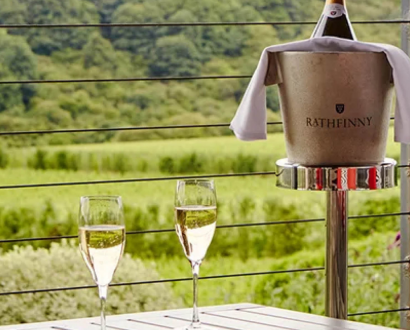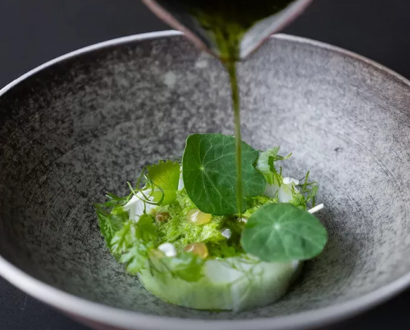Seated around a long, wooden bench among a dozen other wine enthusiasts, we each have five glasses of pinot noir before us and within reach are boards plentiful with cheeses, charcuterie and fruits to enjoy wine with.
Drawn to the generous pours and tempting comestibles rather than the PowerPoint presentation to the side of the room, our small masterclass is gathered by the promise of sampling select pinot noir wines from around the world in this Cellarmasters tasting room in Sydney’s Surry Hills.
We’re greeted by an exuberant Christine Ricketts, Cellarmasters’ Cellar Director and Wine Educator, who emanates a strong passion and knowledge of wine, taking the group’s concentration levels up a notch as we sip on our aperitif of bubbles.
She used to be a nurse in a past life, but Christine recognised her palate for wines when she was working at a wine bar in London. Discovering new drops spurred her to study viticulture and oenology at the University of Adelaide when she returned to Australia.
It’s an understatement to call Christine a wine buff; she’s one of the leading wine educators in Australia. Rounding up around 700 aficionados every year with her expertise, she has expertly trained more than 10,000 wine connoisseurs over the past two decades she’s been in the business.
Christine is particularly zealous about pinot noir: a light yet complex grape that is quite a contrast to the robust, bold reds like shiraz often favoured in Australia.
“Find out what style you prefer – young, fresh and fruit driven or wines with a hint of meaty, truffle, forest floor earthiness.” – Cellarmasters Cellar Director and Wine Educator Christine Ricketts
She’s quick to reflect on one of the first pinot noirs she tasted, and one of her most memorable wine-tasting experiences – a cellared wine from the Hunter Valley.
“My first eye-opening moment was when I drank a 1981 Tyrrell’s Hunter Valley in 1990, thinking it would be very average, but I was exposed to layers of complexity – freshness with forest floor, leather and mushroom, silky tannins and balancing acidity and a flavour that just went on and on,” she describes.
“The Hunter Valley is not a place I would look for a pinot but this one was amazing. I’ve had many others since that I have loved for many different reasons, but that memory has always stayed with me.”

A delicate and complex grape
“God made cabernet sauvignon, whereas the devil made pinot noir,” Christine declares, quoting winemaker André Tchelistcheff. She explains how this grape is sensitive, thin-skinned and delicate, and calls for skilled handling to grow, harvest and process correctly.
The grape grows best in cooler climates yet is sensitive to wind and frost exposure on the vine, so it’s not an easy grape to cultivate. “It is a very contrary variety to grow – it grows best in one of the narrowest temperature bands,” she explains, pointing to the cool climes of Victoria, Tasmania and New Zealand for optimal cultivation – and, of course, Burgundy in France from where the grape originates.
Cool-climate regions produce much more age-worthy styles … so we shouldn’t be afraid to lay down our Tasmania, Yarra Valley or Mornington Peninsula pinot noirs to enjoy with a few extra years under the label.
It also requires extra care with fermentation to transform into wine. “When you get it into the winery, absolute care with fermenting the grapes must be taken so as to not spoil the ethereal fruit flavours – as well as the oak you use and for how long,” she explains thoughtfully. “It’s so easy to spoil.”
Christine tells us that each region produces pinot noirs with very distinct characters, from floral notes of rose petals, cherry blossoms or violet to fruity characters of red berries or plum, through to more earthy tones of mushroom or spicy notes of pepper, aniseed or clove.
“Find out what style you prefer – young, fresh and fruit driven or wines with a hint of meaty, truffle, forest floor earthiness,” she says.
“Just don’t buy really cheap,” she adds, “as they will be simple and uneventful.”
While it’s thought that pinot noir is best enjoyed in its first few years after its release, Christine assures that cellaring should not be dismissed. Cool-climate regions produce age-worthy styles, she says, so we shouldn’t be afraid to lay down a Tasmanian, Yarra Valley or Mornington Peninsula pinot noir to enjoy with a few extra years under the label.
Pinot noir from Margaret River
We taste an Abbey View Pinot Noir 2017 first up, from Western Australia’s famed Margaret River wine region, which shares a similar climate to Bordeaux in a dry year.
We’re encouraged to try the wine with whatever we please from the selection of French d’Affinois, truffled cheddar, manchego, jamon serrano, fennel sopressa, duck and orange pâté, shiny squares of quince paste and plump strawberries and blueberries.
“There are certain elements, such as texture and flavour, in both food and wine that interact with each other, and when you find the right combination the whole experience is enhanced,” she explains, “but do remember it is very subjective.”
Traditionally, Australian pinot noirs are lighter in colour with smooth tannins and hints of cherry, raspberry and plum flavours, Christine explains as we take our first tastes and nod in agreement.
Abbey View is very easy to drink – and transports me for a moment to that south-west corner of Western Australia. With bright red fruits and floral notes on the nose, the palate is vibrant and fresh, bursting with flavours of juicy berries and cherries – and it pairs perfectly with the creamy brie and fresh strawberries.
“There are certain elements, such as texture and flavour, in both food and wine that interact with each other, and when you find the right combination the whole experience is enhanced.” – Christine Ricketts
French pinot noir from Burgundy
We then turn to a Pierres Blanches 2017, a Pays d’Oc from the south of France, with an impressive melange of flowery, spicy, savoury and forest floor scents all in one. Immediate hits of light oak with sour cherry and red berries are best savoured with the duck pâté.
France is by far the leading producer of pinot noir in the world, covering almost 30,000 hectares, mostly in the Champagne region, about 200 kilometres from Burgundy. Australia and New Zealand, in comparison, have this variety contained across less than 5,000 hectares in each country.
Burgundy is, after all, the spiritual home of this grape, and produces the most sought-after pinot noirs in the world.
Christine notes that her all-time favourite pinot noir, if money or accessibility weren’t a factor, is a Domain Romanée-Conti la Tache. The estate in Burgundy, often abbreviated to DRC, is considered to be one of the world’s best winemakers producing some of the most expensive wines you can get your hands on.
France is by far the leading producer of pinot noir in the world, covering almost 30,000 hectares. Australia and New Zealand, in comparison, have this variety contained across less than 5,000 hectares in each country.
From Central Otago to Marlborough
The Ribbon Hills Straight Line from Central Otago in New Zealand, still young from last year, is next. It’s silky, smooth and balanced, with a mix of spice, red cherry, fresh berries and floral hints.
New Zealand has unlimited potential for the production of world-class pinot noirs. Although small in landmass, it has at least six cool-climate regions crafting enjoyable drops, including Martinborough, Marlborough, Nelson, Waipara, Canterbury and Central Otago.
Many New Zealand pinot noir producers leave their fruit on the vine much longer than winemakers in Burgundy allow, resulting in plum flavours, heavier textures and a more Syrah-like wine structure. Fruit-driven and powerful, with higher than normal alcohol levels and less acidity, pinot noirs from New Zealand are nothing short of luscious.
New Zealand has unlimited potential for the production of world-class pinot noir. Although small in landmass, it has at least six cool-climate regions crafting delicious wine, including Martinborough, Marlborough, Nelson, Waipara, Canterbury and Central Otago.
But compare a pinot noir from Marlborough to Central Otago and you’ll get something quite different. Central Otago produces pinot noirs that are more muscular, due to the region’s high altitude, accessible sunlight and short summers. The Martinborough and Marlborough regions, in comparison, produce softer varietals that are fruitier and lighter on the palate.
Tasmania’s Centaurus
The Riversdale Estate Centaurus Reserve 2017 from the Coal River Valley in Tasmania was a stand-out. Barrelled in French oak, it has an aromatic nose with intense fruit nuances of cranberry, violet, strawberry and spicy cloves. Smooth yet strong tannins are balanced with a lengthy, powerful, forest floor finish.
Only the finest pinot grapes are chosen for this label, Christine assures, as we savour the dark fruit flavours. She says the grapes are sourced from either a single block or selected from a small number of blocks for barrelling.
Tasmania has uprooted a few green apple trees to make way for growing new pinot noir grapes. The wines from this island state off the coast of Australia’s Bass Strait compare favourably with the equivalent from Burgundy.
The Riversdale Centaurus Reserve 2017 from the Coal River Valley in Tasmania was a stand-out. Barrelled in French oak, it has an aromatic nose with intense fruit nuances of cranberry, violet, strawberry and spicy cloves.
Tasmanian pinot noir, at its best, presents notes of spice, truffles, dark berries and cherry while remaining silky and elegant, Christine informs us as we taste the wine alongside morsels of truffle-infused cheddar.
Victoria’s Yarra Valley
The Dovetail 2018 from the Yarra Valley in Victoria, which has been oaked for 12 months in hogsheads, has notes of lifted red berry fruit with peppery spice. On the palate is bright raspberry and cherry fruit with subtle integrated oak and silky tannins.
Yarra Valley’s cool climate and a slow ripening period produces wines with soft, delicate aromas and complex flavours characterised by light fruit and herbal notes, making it one of the top regions in Australia to produce premium pinot noirs.
Victoria has several regions that produce superb pinot noirs. Mornington Peninsula is known for wines bursting with fruit characteristics, while Geelong produces punchier wines that are more savoury while retaining the silkiness expected from pinot noir.
At the end of the evening, with a cheeseboard mess and five empty glasses in front of us – six if including the Champagne flute from the aperitif – we are all feeling incredibly jolly. From floral to fruity, forest floor to spicy, we’ve experienced all the notes of a complex wine. When it comes to pinot noir, it’s personal; but the Australian and News Zealand varieties certainly stack up against the French.
Visit Cellarmasters’ wide selection of wines.
Want more wine? Explore Wine Enthusiast’s list of the 10 Best Wine Travel Destinations for 2019 or discover award-winning Penfolds Grange winemaker Mike Farmilo’s latest venture.







